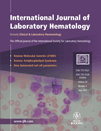
International Journal of Laboratory Hematology
Scope & Guideline
Advancing the science of hematology through innovative research.
Introduction
Aims and Scopes
- Clinical Hematology:
Research articles that explore the clinical implications of hematological disorders, including their diagnosis, treatment, and management strategies. - Laboratory Techniques and Innovations:
Studies focusing on the development and validation of new laboratory techniques, including automated systems, flow cytometry, and molecular diagnostics. - Hematological Disorders and Disease Mechanisms:
Research delving into the pathophysiology, genetic underpinnings, and clinical presentations of various hematological diseases such as leukemias, lymphomas, and bleeding disorders. - Quality Control and Standardization:
Articles addressing the importance of quality assurance in laboratory practices, including the standardization of assays and protocols to ensure accurate diagnosis and patient safety. - Artificial Intelligence and Machine Learning Applications:
Investigations on the use of AI and machine learning techniques in improving diagnostic accuracy and efficiency in hematology laboratories.
Trending and Emerging
- Molecular and Genetic Studies:
An increasing number of studies are focusing on molecular and genetic factors influencing hematological disorders, enhancing the understanding of disease mechanisms and potential therapeutic targets. - AI and Automation in Hematology:
The integration of artificial intelligence and automation in laboratory practices is a rapidly growing trend, with research exploring their applications in diagnostic accuracy and workflow efficiency. - Personalized Medicine and Treatment Approaches:
Research is trending towards personalized medicine, with studies investigating how genetic profiling and individual patient characteristics can inform tailored treatment strategies. - Quality Assurance and Laboratory Standards:
There is a heightened emphasis on quality control measures and standardization practices in laboratory hematology, aiming to improve diagnostic reliability and patient safety. - Impact of COVID-19 on Hematology:
The journal has seen a surge in publications related to the effects of COVID-19 on hematological parameters, coagulopathy, and the management of hematological conditions during the pandemic.
Declining or Waning
- Traditional Morphology-based Diagnosis:
The reliance on traditional morphological methods for diagnosing hematological conditions appears to be waning, as more emphasis is placed on molecular diagnostics and advanced imaging techniques. - Basic Laboratory Techniques:
There is a noticeable decline in publications focused on basic laboratory techniques that have been well established, as researchers increasingly explore more advanced and innovative methodologies. - Single Case Reports:
The frequency of single case reports has decreased, possibly due to a shift towards larger cohort studies and multi-center trials that provide more comprehensive data. - Descriptive Studies:
Descriptive studies that do not employ rigorous statistical analysis are becoming less common, as there is a growing demand for studies that offer robust data and conclusions.
Similar Journals

Hematology Reports
Bridging gaps in blood disorder treatment.Hematology Reports is an esteemed academic journal in the field of hematology, dedicated to advancing the understanding of blood disorders and their treatment. Published by MDPI, a leading Swiss publisher known for its commitment to open access since 2009, this journal provides a valuable platform for researchers and healthcare professionals to disseminate innovative findings and foster collaboration within the academic community. The journal features an array of articles ranging from clinical studies to laboratory research, and is indexed in Scopus, where it currently holds a rank of 113 out of 137 in the Medicine - Hematology category, placing it in the 17th percentile. As an open-access journal, Hematology Reports ensures that critical research is accessible to a global audience, supporting the dissemination of knowledge that has the potential to improve patient outcomes. This journal is an essential resource for those engaged in the study and treatment of hematological conditions, encouraging dialogue and the exchange of ideas to enhance clinical practices.
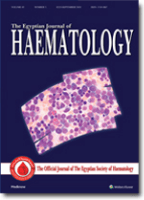
Egyptian Journal of Haematology
Shaping the Landscape of Hematology in the Middle EastThe Egyptian Journal of Haematology, published by WOLTERS KLUWER MEDKNOW PUBLICATIONS, stands as a pivotal resource in the field of hematology, particularly within the context of Egypt and the broader Middle Eastern region. This journal is dedicated to disseminating high-quality research that explores the latest advancements in blood disorders, hematologic malignancies, and transfusion medicine. With a focus on original research, case studies, and reviews, it aims to provide a comprehensive platform for hematologists, researchers, and healthcare professionals to enhance their understanding and management of hematological conditions. Although it is not an open-access journal, the rigorous peer-review process ensures that only the most impactful studies are published, contributing to the journal's reputation in the academic community. The Egyptian Journal of Haematology serves as an essential tool for advancing knowledge, improving clinical outcomes, and fostering collaboration among experts in the field.
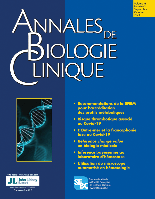
ANNALES DE BIOLOGIE CLINIQUE
Fostering Collaboration in Clinical and Laboratory ScienceANNALES DE BIOLOGIE CLINIQUE is a prominent French journal dedicated to advancing the fields of Biochemistry, Genetics, Molecular Biology, Immunology, and Microbiology. Published by JOHN LIBBEY EUROTEXT LTD, this journal has been a pivotal resource since its inception in 1945, offering a rich archive of original research, reviews, and clinical studies that aim to bridge the gap between laboratory findings and clinical applications. Despite its ranking in the Q4 quartile within several scientific categories according to the 2023 Scopus rankings—positioning it at #395/636 in General Medicine and #198/221 in General Biochemistry—ANNALES DE BIOLOGIE CLINIQUE serves as a vital platform for emerging researchers and seasoned professionals alike, fostering collaboration and innovation in these vital areas of health science. As an essential tool for researchers and scholars, the journal does not currently provide open access; however, it continuously strives to enhance its impact and visibility in the scientific community through rigorous peer-reviewed content and educational contributions.

Journal of Blood Medicine
Unlocking Potential: Transforming Knowledge into Practice in Blood MedicineThe Journal of Blood Medicine, published by DOVE MEDICAL PRESS LTD, stands as a vital resource in the field of hematology, focusing on the latest research developments and clinical advancements in blood medicine. With an impact factor reflective of its growing relevance, this open-access journal has been delivering quality scholarly work since 2010, ensuring that critical research is readily available to the global scientific community. The journal operates under an open-access model, further enhancing its dissemination and accessibility to researchers, professionals, and students alike. In the 2023 rankings, it secured a Q3 category status within hematology and achieved a commendable 76th rank out of 137 in Scopus listings, indicating its commitment to quality and innovation in this specialized area. Located in New Zealand, the journal's diverse topics encompass clinical research, treatment modalities, and emerging therapies, contributing significant insights vital for shaping future advancements in blood medicine.
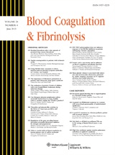
BLOOD COAGULATION & FIBRINOLYSIS
Fostering Collaboration in Coagulation ResearchBLOOD COAGULATION & FIBRINOLYSIS, a distinguished journal in the field of hematology, is published by Lippincott Williams & Wilkins, a reputable name in academic publishing. Since its inception in 1990, this journal has been committed to advancing the understanding of blood coagulation and fibrinolysis, focusing on the molecular mechanisms, clinical implications, and therapeutic aspects of these critical processes. With an impact factor reflecting its significance within the academic community, currently ranking Q3 in both Hematology and Miscellaneous Medicine for 2023, this journal serves as a pivotal platform for researchers and professionals alike. By providing access to cutting-edge research and reviews, BLOOD COAGULATION & FIBRINOLYSIS endeavors to foster collaboration and innovation in the treatment of coagulation disorders. Interested readers can explore ongoing contributions to the field through subscriptions and institutional access options.
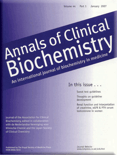
ANNALS OF CLINICAL BIOCHEMISTRY
Pioneering Insights for Clinical Excellence.The Annals of Clinical Biochemistry, published by SAGE Publications Inc, is a prestigious journal that has been pivotal in advancing the field of clinical biochemistry since its inception. With an ISSN of 0004-5632 and an E-ISSN of 1758-1001, this journal provides a platform for high-quality, peer-reviewed research articles, reviews, and case studies that cover a wide range of topics, including biochemical analysis, diagnostic methodologies, and the latest advancements in clinical practices. As a recognized leader in the field, it holds a Q2 ranking in both Clinical Biochemistry and Miscellaneous Medicine categories, showcasing its contribution to the evolving landscape of medical science. The journal’s impact is further underscored by its strategic emphasis on fostering collaboration between researchers and healthcare professionals. Although it does not provide Open Access options, the accessible subscription model ensures that vital research remains within reach of academic and clinical institutions. The Annals of Clinical Biochemistry aims to promote the understanding and application of biochemical techniques in clinical settings, ensuring it remains an essential resource for researchers, professionals, and students alike.
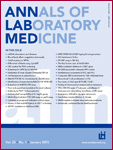
Annals of Laboratory Medicine
Advancing the Frontiers of Laboratory MedicineAnnals of Laboratory Medicine, published by the KOREAN SOC LABORATORY MEDICINE, stands as a pivotal resource for researchers and practitioners in the fields of clinical and medical biochemistry. With a strong Q2 ranking in both Biochemistry (medical) and Clinical Biochemistry, along with a prestigious Q1 status in miscellaneous Medicine categories, this journal emphasizes the significance of laboratory medicine in improving patient outcomes and advancing scientific understanding. Established in 2012, the journal has demonstrated an impressive trajectory of growth and scholarly contribution, making it a reliable source of high-quality research and insightful reviews. The journal utilizes open access, enhancing the reach of its findings across the global scientific community. Operating from South Korea, Annals of Laboratory Medicine aims to foster dialogue and collaboration among professionals, contributing to the continuous advancement of laboratory methodologies and diagnostics.

Journal of Hematology & Oncology
Pioneering Discoveries in Hematology and OncologyJournal of Hematology & Oncology, published by BMC, is a leading open-access journal dedicated to the dynamic fields of hematology and oncology, with a continuous publication record since 2008. Based in the United Kingdom, this prestigious journal provides a platform for groundbreaking research, encompassing topics that span cancer research, hematological disorders, and molecular biology. With a remarkable Q1 ranking in multiple categories including Cancer Research, Hematology, Molecular Biology, and Oncology for 2023, it stands as a significant contributor to the scientific community. The journal's rigorous peer-review process ensures the dissemination of high-quality studies that drive advancements in these critical areas of medicine, boasting an impressive Scopus rank in the top echelons of its fields. As an open-access publication, it promotes widespread accessibility and sharing of knowledge, making it an indispensable resource for researchers, clinicians, and students striving to make advancements in understanding and treating hematological and oncological diseases.
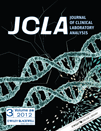
JOURNAL OF CLINICAL LABORATORY ANALYSIS
Pioneering research in clinical laboratory analysis.JOURNAL OF CLINICAL LABORATORY ANALYSIS is a premier, peer-reviewed journal published by WILEY, focusing on the expansive field of laboratory medicine. With its ISSN 0887-8013 and E-ISSN 1098-2825, this open access journal has been serving the scientific community since 1987. As of 2023, it holds a notable impact in various domains, achieving category quartiles in Biochemistry, Clinical Biochemistry, Hematology, and more, showcasing its significance across multiple disciplines such as Medical Laboratory Technology and Public Health. Ranked impressively, it is placed 7th in Medical Laboratory Technology, reflecting its crucial role in advancing clinical practice and research. The journal aims to disseminate innovative research findings, methodologies, and reviews that can catalyze advancements in laboratory practices and improve patient outcomes. Accessible to a global audience since its transition to open access in 2019, the journal is not just limited to professionals but is also a valuable resource for students and researchers seeking to stay updated in this dynamic field. For more information, visit the journal's website.
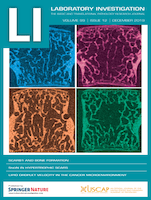
LABORATORY INVESTIGATION
Unveiling Insights in Forensic and Molecular ResearchLaboratory Investigation is a premier academic journal published by Elsevier Science Inc, specializing in the fields of Pathology, Forensic Medicine, Cell Biology, and Molecular Biology. With its ISSN 0023-6837 and E-ISSN 1530-0307, this journal has been a significant contributor to scientific discourse since its inception in 1952, converging into its current form by 2024. It holds an impressive standing in its respective fields, featuring a 2023 Journal Rank of Q2 in both Cell Biology and Molecular Biology, and an elite Q1 ranking in Pathology and Forensic Medicine, reflecting its influence and quality of research, as seen in its Scopus ranks—17th out of 208 in Pathology and Forensic Medicine. Although it does not offer Open Access options, the journal remains a vital resource for researchers, professionals, and students who seek to disseminate and engage with high-caliber research findings. The importance of Laboratory Investigation is underscored by its commitment to advancing the understanding of laboratory and translational medicine, paving the way for innovations that enhance clinical practices.